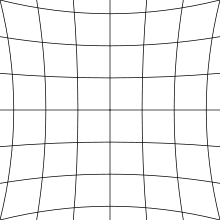Curvilinear perspective


Curvilinear perspective is a graphical projection used to draw 3D objects on 2D surfaces. It was formally codified in 1968 by the artists and art historians André Barre and Albert Flocon in the book La Perspective curviligne,[1] which was translated into English in 1987 as Curvilinear Perspective: From Visual Space to the Constructed Image and published by the University of California Press.[2]
Background
In 1959, Flocon had acquired a copy of Grafiek en tekeningen by M. C. Escher who strongly impressed him with his use of bent and curved perspective, which influenced the theory Flocon and Barre were developing. They started a long correspondence, in which Escher called Flocon a "kindred spirit".[2]
Horizon and vanishing points



The system uses curving perspective lines instead of straight converging ones to approximate the image on the retina of the eye, which is itself spherical, more accurately than the traditional linear perspective, which uses straight lines and gets very strangely distorted at the edges.
It uses either four, five or more vanishing points:
- In five-point (fisheye) perspective: Four vanishing points are placed around in a circle, they are named N, W, S, E, plus one vanishing point in the center of the circle.
- Four, or infinite-point perspective is the one that (arguably) most approximates the perspective of the human eye, while at the same time being effective for making impossible spaces, while five point is the curvilinear equivalent of one point perspective, so is four point the equivalent of two point perspective.
This technique can, like two-point perspective, use a vertical line as a horizon line, creating both a worms and birds eye view at the same time. It uses four or more points equally spaced along a horizon line, all vertical lines are made perpendicular to the horizon line, while orthogonals are created using a compass set on a line made at a 90-degree angle through each of the four vanishing points.
History
Earlier, less mathematically precise versions can be seen in the work of the miniaturist Jean Fouquet. Leonardo da Vinci in a lost notebook spoke of curved perspective lines.[2]
Examples of approximated five-point perspective can also be found in the self-portrait of the mannerist painter Parmigianino seen through a shaving mirror. Another example would be the curved mirror in Arnolfini's Wedding by the Flemish painter Jan van Eyck.
The book Vanishing Point: Perspective for Comics from the Ground Up by Jason Cheeseman-Meyer teaches five and four (infinite) point perspective.
Geometric relationship

Distances a and c between the viewer and the wall are greater than the b distance, so adopting the principle that when an object is a greater distance from the observer, it becomes smaller, the wall should be reduced and thus becomes distorted at the edges.

Mathematics
If a point has the 3D Cartesian coordinates (x,y,z):
Denoting distance from the point to the origin by d = √x2 + y2 + z2,
then the transformation of the point to a curvilinear reference system of radius R is
(if d = 0, then the point is at the origin, which means its projection is undefined)
This is derived by first projecting the 3D point onto a sphere with radius R that centers on the origin, so that we obtain an image of the point that has coordinates
Then, we do a parallel projection that is parallel with the z-axis to project the point on the sphere onto the paper at z = R, thus obtaining
Since we are not concerned with the fact that the paper is resting on the z = R plane, we ignore the z-coordinate of the image point, thus obtaining
Since changing only amounts to a scaling, it is usually defined to be unity, simplifying the formula further to:
A line that does not pass through the origin is projected to a great circle on the sphere, which is further projected to an ellipse on the plane. The ellipse has the property that its long axis is a diameter of the "bounding circle".
Examples
-

Jean Fouquet, Arrival of Emperor Charles IV at the Basilica St Denis
-

Parmigianino, Self-portrait in a Convex Mirror
-
.jpg)
Detail of convex mirror in Jan van Eyck's Arnolfini Portrait, 1434
See also
- Graphical projection
- Perspective projection distortion
- linear perspective
- Mathematics and art
- M. C. Escher
- Curvilinear coordinates
References
- ↑ Albert Flocon and André Barre, La Perspective curviligne, Flammarion, Éditeur, Paris, 1968
- 1 2 3 Albert Flocon and André Barre, CurvilinearPerspective: From Visual Space to the Constructed Image, (Robert Hansen, translator), University of California Press, Berkeley and Los Angeles, California, 1987 ISBN 0-520-05979-4